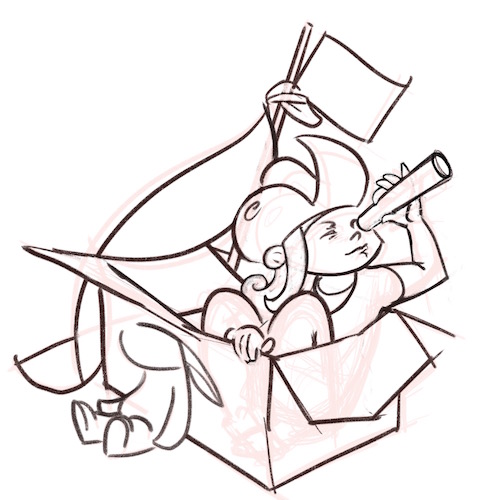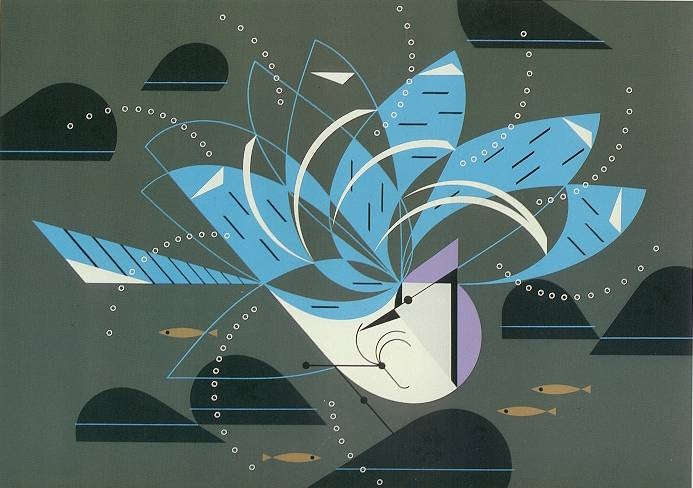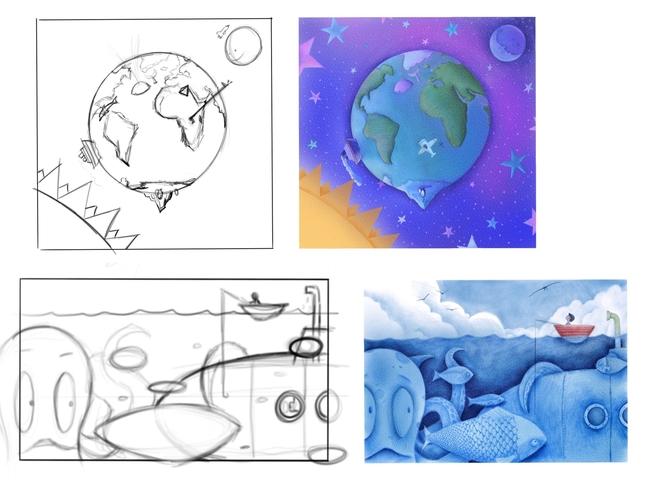Evolving style
-
I like to experiment with different rendering styles on my social media channels (not in my portfolio generally), but since some time I am also feeling a need to evolve my drawing style. I would like to increase the stylization level, focus more on shapes rather than volumes and go into a more design-driven and less realistic approach. I have been studying a lot of artists that I think do this very successfully - Szymon Biernacki, Jon Klassen, Meomi, Poly Bernatene, Stephen Silver, Benji Davies, William Joyce, Lorena Alvarez, etc...Also studying still frames from "The Secret of Kells" and "Song of the Sea" (my, are those movies beautiful!!). Still, I find it very difficult to break free of the "pull of realism", and I am so far disappointed with my attempts. They totally lack that sense of balance and harmony that I see in the work of these artists.
How do you evolve your style while staying true to yourself? No magic trick expected, but maybe experiences, ideas, advice?Here is my latest experiment..

-
@smceccarelli I've been feeling the need to do this too. Most of the artists I admire and the artwork I'm drawn too have really amazing shapes in their characters. You can love that style and be glad it's there and stay true to what you make too. I've done private copies of different artist's characters to get the feel of their work and later applied it, but I usually find myself just adapting. It's still my work, with maybe some new "tricks." You're not alone!
This is a darling piece btw, I love everything you're doing! I can always identify your work no matter what style you use.

-
@smceccarelli nice - i particularly like those creases in the cardboard flap (such a minor detail for me to pick upon and specifically comment on, right? Nevertheless, I like it!)
At the moment, I more so have a couple clarifying questions. You said:
"I am also feeling a need to evolve my drawing style"
Why?
And you said:
"How do you evolve your style while staying true to yourself?"
What do you mean by "evolve your style"?
I ask, because this sounds like you want to intentionally change the way you view & represent characters/objects/environments and concepts/stories, etc. Almost as if you don't want to be you.
I understand wanting to improve your own work and being inspired by aspects of work from others that might be different than your own typical work, such as the emphasis of simplification, exaggeration, & line-flow of stylized work.
Which brings me to my 3rd question(s):
What makes you want "to increase the stylization level" of your work? Is there anything(s) in particular driving you this way?
Regarding my experiences:
I have noticed that I tend to naturally have a few different approaches to things (highly graphical/stylized, caricature with high rendering, & more cartoony rendered somewhere in between cell-shading & high rendering with bold line work). With the idea of "evolving my style", I have been seeking to find a way to blend these approaches. Obviously, I am seeking to improve my drawing, rendering, & concept/narrative-conveying skills all the while; however, this evolution is more of a blending & refinement of what I do naturally rather than aspiring to be something I'm not.
...Of course... I do have pieces & artists I see that are inspirational & aspirational; ones that have approaches that I would like to pursue... the way the artist handled line, shape, construction, volume, balance, harmony, composition, lighting, coloring, etc. I see these things and think, "This is something I like a lot, that is better than what I am doing, and something I need to incorporate." Perhaps this is what you mean by "evolve your drawing style".
Hmm... as I type this, I am actually going through a pursuit of "style evolution" right now... Both in drawing & rendering, but very specifically with rendering, I am wanting to be more painterly. Right now, I'm just playing, attempting to find my comfort zone in this approach. Later, after I have reached a plateau of consistency & comfort, I'll probably push myself out of my comfort zone by pursuing a bit more. I think that is how I am approaching drawing & character/object construction too. In both cases, I'm not attempting to emulate any artist or artwork, but I am certainly being informed & guided by them.
I might not state this so much as "evolving style" but more as "growing/maturing in skills". In the end, I'm just not going to be a highly realistic drawing kind of person. I am simply far too caricature, exaggeration/stylization, & humor minded. And I'm just not going to be a highly dainty, whimsical line & paint, super painterly kind of person. There is too much pull towards bold, heavy, intense, etc.
Perhaps I'll change in the future for some reason, but for now, this is who I seem to be and rather than try to change it, I'm seeking to improve in it. (Note: I view becoming a bit more painterly as improving as well as things like moving from a typical reliance upon dark midtones popped with lights to light midtones popped with darks, and as well as working on character/object construction, line flow, etc.)
BTW, It's been awhile since I read this (and I'm sure you have read it before) but it may help in regards to "the issue of style":
http://www.gcastellano.com/arttips/forgetstyle
Haven't read this yet but have it sitting in a browser tab waiting for me to spend the time to read:
https://medium.com/@kyleTwebster/the-style-problem-for-artists-bb4c79f2582e
-
@smceccarelli I think you're doing great! I really feel that style is mostly a result of mileage than anything else. If you're concious of they types of illustration you love and the market you want to target your portfolio to I think over time you'll evolve in the direction you want to go. Staying experimental is also key and something that many people neglect. Constantly asking yourself, "must I do it this way?...can I do it differently?"
-
@QuietYell Thank you for your perspective and input! I realize I have not framed the question properly. I am not trying to "find my style" - I know you cannot find style anymore than you can "find" your handwriting or the way you walk and speak. There will always be the element of "me" in whatever direction I steer.
After Jake Parker's post about inpirations, I pulled together the artists I like and love at the moment (that tends to change with time). More than half of them do what I call "design-driven" work and are totally different from the other half. In my pool of inspirations at the moment there are artists as different as Greg Manchess and Stephen Silver, Carter Goodrich and Claire Wendling. I find it difficulty to see why I am attracted by such opposites and how I can learn from both...if at all possible. I know I want to play at the border between shape and volume somehow (I wrote this in my artist statement years ago already), but I still have no clue how to do that...
On top of that there is the input from various portfolio reviews that I should "push the design aspect more" and get "less tangled up in detail and rendering" - which I can see for myself, but how?
Also, I get bored very easily, and I would love to have 2 or 3 well developed styles I could move between depending on the project.
@Will-Terry thank you for tuning in, and of course you are right - it is about constantly challenging oneself to try new things and experiment - and trusting that by putting in the work, things clarify and evolve by themselves.
In one of the courses, you mentioned a picture book artists who works in several different styles. Could you remind me his name? -
@smceccarelli Eric Rohmann is one with a variety of styles. He was my mentor a few years ago at the Highlights Advanced Illustrator Workshop. Awesome artist and teacher.
http://www.ericrohmann.com/index.html
Those are some of my fav artists you mentioned, their use of color and shape is very intentional and there seems to be a bit more balance in the way they handle texture.
I think it may be easier to start with a more limited color palette like Jon Klassen. He uses lots of different textures but the limited color balances out all the texture activity Vs Benji Davies who goes bold with color but he keeps his textures somewhat limited to a couple brushes.
You are doing wonderfully!
I absolutely love your Dragon and boy reading books piece!
-
@Charlie-Eve-Ryan Thank you! He is exactly the one I was looking for!
-
@smceccarelli Ahh...I see...I like the way you think...I can't remember who I was talking about - the guy with multiple styles?
W
-
@smceccarelli Oh - I should have read further
 Yes - Eric R is amazingly diverse.
Yes - Eric R is amazingly diverse. -
@smceccarelli @smceccarelli Great as usual! Couple things pop out to me on this - i'm trying to imagine how her body is sitting and i feel like we would maybe see her knees? Other thing might be the sleeve on her raised arm should possibly be turned out to imply that her arm is going out to the side? i don't think i really solved anything in my draw over but i tried to show the things i am talking about


-
Personally, I think of the development of an artistic "style" as being much the same thing as developing handwriting.
Kids learning to write generally make similar mistakes and all form their letters pretty closely to how their teacher showed them. But the more they write (and just as importantly, the more they read) their writing gradually (over a period of YEARS) gets more confident and distinct. Eventually, their writing is so unique and recognizable that things such as a person's signature are distinctly identifyable, even for legal documents. And there are those people who through practice and study of calligraphy can confidently write with multiple types of handwriting.
I think there are things you can intentionally do to change/develop your style, and trying to study and emulate favorite artists is definitely a big one. But to a certain extent, its just putting in the time and becoming confident in the way you put things on the page.
Just my 2 cents

-
If I may give my opinion, please forgive me if it is not the opinion you are looking for. I do not have an art degree, so much of what you said I understand, but means little because this is still great art.
However, let me tell you what I do see:
My first impression was that this was great. I think most people and I have never read a decent children's book where we dissected the art with a critical eye while reading it to ourselves or to our children. So, I immediately noticed the box; I am enthralled by your realistic, cardboard texture on the box.Now, what I see with my "un-degreed" eye-- if I were to get all critical-- are missing fingernails and an eyepatch that could be mistaken for a nose.

-
@smceccarelli I know you already know the benefits of master studies, and I'm sure you have done a lot of these...they really helped me when I was having a worry about 'style' and wanting to capture a little bit more technique from artists I admired - including a copy of a Benji Davies piece, I love his work too :-). If you were to do a master study of one of those artists you mentioned, then a sketch of your own....then a different artist's master study, then another personal sketch...then repeat a third time...I'm sure you would be in a different place to where you are now (in terms of asking this question, I mean maybe you will know a little bit more which techniques you like to borrow and which you don't).
Another idea for an exercise...I just finished being in the 50 Things critique class where Will was giving some tips about style to @bharris ...he was reluctant to suggest that anyone should try to change, as he wants people to innovate not chase other people - but as a way to break out a little, he mentioned that you can try doing a piece where you pretend to be three different artists simultaneously - so you borrow a little bit from each artist in a single piece and combine them. Maybe that might be interesting to try? I would like to see the results for sure, if you try it out! (and I will have to try it myself sometime)
-
@Dulcie You hit the nail on the head with your comments and suggestions. That is exactly what I am doing right now. I collected a number of children books and art books from the artists that have that ineffable "iconic" design sense and I am going back to school with them as my teachers - making copies and designing my own, exactly as you describe it. I feel the need to experiment a bit. I want to stretch my wings a little into unknown territory and see what I can bring back into my own world.
I also got the Benji Davies book from which you made your copy: "The Dragon and the Nibblesome Knight." Such a delightful book, it's a little jewel!On that note - I fell in love with another artist a world apart from me: Charley Harper. He was active in the 40s and 50s - his work is just unbelievable...stunning in a "making-art-history" way:


-
@Kevin-Longueil Thank you Kevin, you are absolutely right! I have corrected the pose!
-
I love your art, and think it is cool you are trying new things. I for one naturally draw and design more flat images, but like the render them so they pop a bit. So for me, the whole process of flattening things out is in the character design and layout of the envirenment. Something I did was look at Lee White's images on his website and then turned every image he did into thumbnails to see how he designs in a more 2d way, and it really push my style. My rendering is very much influenced by Will Terry and Jake Parker. Here is an example of my thumbnails as flat, and then the rendering.

Hope it isn't innapropriate to post my art in your thread.

-
Charley Harper is classic. I LOVE his work. You wouldn't know it by looking at mine though ;-). Well, not my illustrations at least, though some of my craft stuff is more geometric.
Its so fun discovering new (to you) artists, but sometimes it makes me feel a bit inadequate as well.
I just have to keep reminding myself--nobody is better at being me than ME. I can't draw their style as well as they can, but nobody can draw my style as well as I can. (Now, the job is just getting my work to the level that someone would actually WANT to emulate my style ;-).